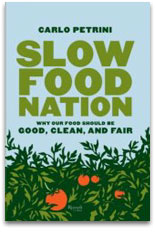This is the fourth in a series of articles about connecting with people over food. Read others on setting up a dining co-op, celebrating Passover, and hosting an Earth Dinner.
When I told a friend that I was writing an article about slow food, she said, “What’s that? The opposite of fast food?” In a word, yes.

Carlo Petrini.
Photo: slowfood.de
The first time I heard about the slow-food movement several years ago, I had no idea what to make of it either. It turns out that the movement champions foods that are authentic to certain regions, working to preserve biodiversity in plant crops and animal breeds that are at risk of extinction. Slow food also supports artisanal techniques used to prepare such foods. It is an international movement that has 80,000 members and local chapters in 50 countries. The chapters, called convivia, sometimes hold potlucks as a way for members to get together and talk over food-related topics … but I’m getting ahead of myself. Let’s begin at the beginning.
The slow-food movement was initiated in 1986 by Carlo Petrini, an Italian wine writer, gastronome, and conservationist with several books to his name, including Slow Food Nation, out this week. According to the Slow Food Manifesto, Petrini feared that industrialization was leading to standardized food and flavors: “Concerned that the world was quickly reaching a point of no return, he wanted to reach out to consumers and demonstrate to them that they have choices over fast food and supermarket homogenization. He rallied his friends and began to speak out at every available opportunity, and soon the movement was born and Slow Food was created.”
The organization now oversees several major projects, including the Ark of Taste and the Presidia, which are projects of the Slow Food Foundation for Biodiversity, and the biannual Terra Madre conference and Salone del Gusto food festival in Italy. In addition, Slow Food has recently founded the University of Gastronomic Sciences, which confers an undergraduate degree in gastronomic sciences and a master’s in food culture, taught at two campuses in Italy. These projects are all described in the downloadable Slow Food Companion (worth reading for the design elements alone!).
The Ark of Taste is a collection of agricultural foods at risk of extinction, and the Presidia offers financial and technical support to keep these products in circulation. Slow Food was motivated to undertake these projects because, according to their manifesto, 75 percent of European food-product diversity and 93 percent of American food-product diversity has been lost since 1900, 33 percent of livestock varieties have disappeared or are near disappearing, and 30,000 vegetable varieties have become extinct in the last century, with one more lost every six hours.
The logic behind the program is that if the products can have an economic impact, they can be saved from extinction. While the best way to preserve many things is not to use them, with agricultural foods the best hope lies in creating demand. That, in turn, encourages farmers to keep the plants in cultivation and the animal breeds in use.
“In order to save them you have to eat them,” explains Rosemary Melli, governor of the New England Slow Food region. “We need to create a demand for them. We encourage chefs, markets, and small specialty stores to stock these foods.”
The Slow Food website has a list of the foods in each country’s ark. North American foods include red fife wheat in Canada and, from the U.S., Anishinaabeg manoomin rice, Cape May oysters, Navajo-Churro sheep, raw milk cheese, Sonoma County Gravenstein apples, and, recently added, the bison of the Great Plains.
Next time I’ll write about all the projects of Slow Food USA, including some exciting ones that are just on the horizon, as well as how to join a local convivium and how to host or attend a slow-food potluck. In the meantime, you can learn more about joining Slow Food USA.
Here is a recipe from Rosemary Melli that’s great to take to a potluck. I like it because it contains some balsamic vinegar for a little bit of zing.
Italian Bean Dip

1/4 cup extra-virgin olive oil
1 onion, chopped
2 cloves garlic, finely chopped
1 1/2 cups canned cannellini beans (good quality), drained and rinsed
3 tablespoons good quality balsamic vinegar
2 tablespoons finely chopped fresh basil
1/4 teaspoon crushed red pepper
salt and pepper to taste
extra olive oil for drizzling
In medium saucepan, heat oil on low flame, and cook onion, stirring often, for 10 minutes.
Add garlic and cook 1 minute, stirring.
Stir in beans and heat until blended.
Add vinegar, basil, red pepper, salt, and pepper.
In a food processor with steel blade, work mixture until smooth. It should just hold its shape. If it seems too thick, add a spoonful of water. Transfer to a bowl, drizzle generously with olive oil, and serve at once with crusty bread or veggies.



